TWO RELIGIONS AND A ROYAL KINGDOM – THE GLORY THAT WAS ANGKOR – By Bernard VanCuylenburg
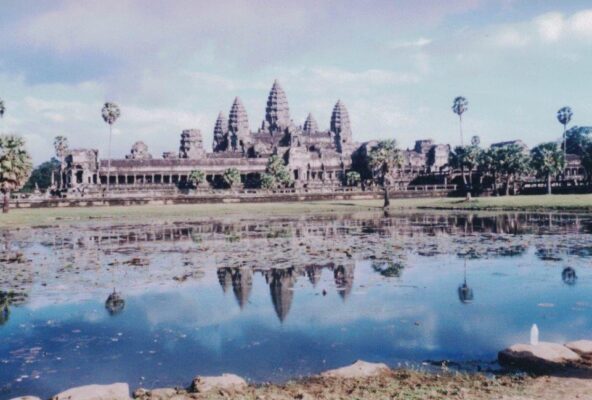
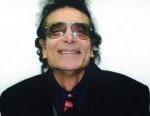 PROLOGUE.
PROLOGUE.
Dr.Henri Mouhot the French Naturalist was doing what he loved best, searching for new species of flora in a leafy green forest which was his passion. Pressing even deeper into a green kingdom glinting with birds of every variety, and flora and fauna of every description, tropical heat notwithstanding, he set to work with a passion. Suddenly, something in the forest beyond caught his eye. Amid the thickets he and his workers spotted a massive structure that resembled what looked like a temple and colossal stone steps thrown down by trees which had grow between the crevices, and reached a terrace the form of which was impossible to make out. As a guide cleared a path with his machete, they came across another colossal structure half buried in the density of the forest in which it was enveloped. The rest is not just History, but cultural gold – The legendary kingdom of Angkor was “discovered” to the world. Although much has been said and written about the “discovery” of Angkor Wat, if truth be told this enchanting kingdom unlike cities such as Pompeii, Herculaneum, and Sigiriya never slumbered in desertion lost to the world in the embrace of thick jungle, or buried underground. Specially in the Far-East, Angkor was never forgotten. In the early years of the 13th century, a member of the Chinese Ambassador’s diplomatic entourage to Cambodia named Chieu Te-Kuan kept a detailed account of many aspects of life in the Khmer Kingdom. His manuscript lies in a museum somewhere in Beijing and sadly has never been published as a book. A Japanese traveller visited Angkor and drew a plan of the site at the beginning of the 17th century, and in 1715 a copy was made of his drawing. A Frenchman P.Chevreul travelled to the site in 1768, and waxed eloquent on the fame of this great kingdom, stating that ” Angkor was as famous as Rome is to the Christians”. Many missionaries from the West visited the country, but their testimonies were confined to the archives in monasteries and were never published. In the West therefore, Angkor was practically unknown. It was a Frenchman P. Bouillevaux, who first published a description of Angkor in 1858. Although this publication enjoyed wide circulation, the beauty of this abandoned city escaped the author’s eye.(“There are none so blind as those who will not
see ?”). But it was Henri Mouhot the French Naturalist who overcome by the splendour of the ruins. published an article in a magazine titled “Le Tour du Monde” (A World Tour) and soon an army of explorers, missionaries, scientific researchers, historians and archaeologists applied themselves to the study of the ancient Khmer capital. The scholarly floodgates were opened between 1863 and 1867 when a German traveller drew public attention to the beautiful inscriptions on the stone slabs which interested most epigraphists.
THE GOLDEN AGE OF AN ARCHAEOLOGICAL FAIRY TALE.
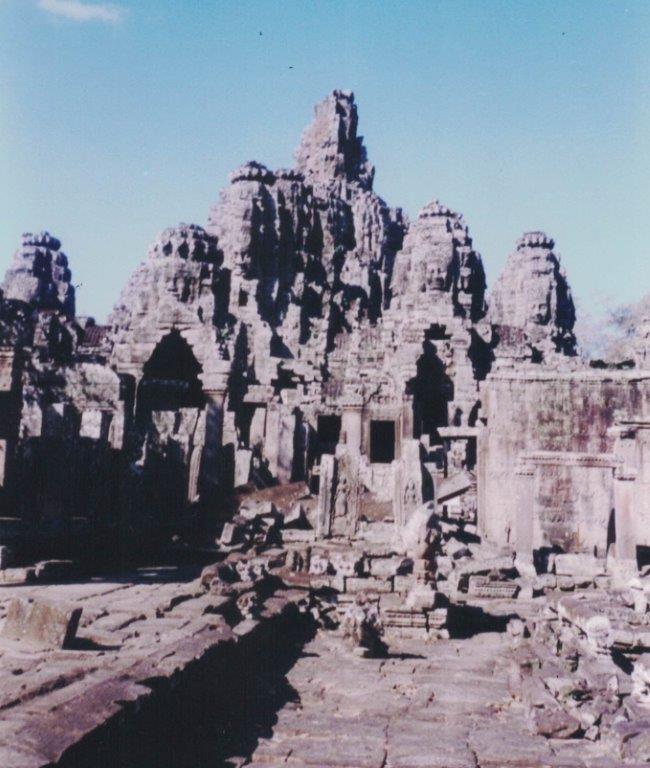
After Henri Mouhot’s “rediscovery” the first task was to liberate the monuments of the ancient capital from the clutches of the forest which proved a difficult task because most of these were half buried in the earth and masses of fallen rock. In 1908 the first Preservationist J.Commaille began the excavation of the great square of Angkor Thom from the stranglehold of the jungle. After his death his successor H. Marchal, cleared away everything nature had buried, and in 1919 a mammoth excavation was undertaken to present the temples outside the city to the world. We are not talking about a few temples, but many buildings of gigantic proportions built of massive stone blocks, not to mention the other pillars, statues and other buildings on par with those of ancient Rome and Greece. The vast complex of Angkor Wat which is the largest religious structure in the world comprises more than a thousand buildings and covers an area of 400 acres. Cambodia as a country is so proud of this national treasure that it forms part of the national flag. It must be mentioned that Angkor is the most famous temple in the Angkor Archaeological Park.
THE HALLMARK OF KHMER ARCHITECTURE.
Visually stunning, the entire complex, temples, wall carvings, pillars, other buildings, and the degree of ornamentation and super human standard of architecture, retain the power to remind visitors of the awesome might of the Kings responsible down the ages for its construction and maintenance.
The dizzying buildings hewn from solid rock and then turned into works of art are a masterpiece of human creative genius. The extraordinary construction of Angkor Wat makes it very difficult to describe with a pen because it is unique and bears no resemblance to any other building in the world. No matter which section of the complex one visits, one is rendered almost breathless when confronted with the rich ornamentation, and breath taking bas-reliefs still in pristine condition which detail battle scenes from Hindu mythology and literature.The supreme architectural, cultural, and archaeological importance of the ancient Khmer architects and engineers, have left the world a lasting legacy which dazzles the world today, and is undoubtedly their greatest legacy.
ANGKOR – THE GENESIS OF A CULTURAL CORNUCOPIA.
In the year 889 AD. King Yashovarman was crowned King of Cambodia, succeeding his father King Indravarman. He founded the capital city which was named after him, Yashodarapura. In time this name was changed to Angkor which became the capital of the Cambodians. He inherited a kingdom which had been well organized and administered. His successor King Jayavarman the second undertook the task of unification and extended his kingdom to the Mekong valley. However, the Angkor Wat temple complex seen today was commissioned by King Suryavarman the second early in the 12th century. With an enclosing wall and a wide moat, the main temple was built in an area famous for its ancient buildings and was dedicated to the God Vishnu. But when the country converted to Buddhism in the late 13th century, many Buddhist dedications were built over the Hindu designs, and this temple according to Historians was King Suryavaman’s last resting place. It is no exaggeration to say that this funeral complex rivals the Pyramids of Egypt. Surrounding the temple complex is a wall 15 ft.high. This wall, its towers and the grand gateway are a feast for the eyes with their carvings and bas – reliefs all richly decorated. But for a supreme masterpiece spectacular beyond belief, a visit to the “Churning of the Ocean of Milk Gallery ” is not to be missed. Here there are 49 sculpted bas-reliefs depicting the Battle of Kurukestra, the Ramayana, the 37 Heavens and 32 Hells, and King Suryavarman himself (1113 – 1150 ) going into battle. The relief also portrays the Devas and the Asuras in a dramatic tug-of-war representing a struggle between good and evil that churns Amrit, the elixir of everlasting life from the ocean. This astonishing panel of sculpture was worked in stone 900 years ago and has no equal in any form of sculpture in South East Asia.
The sight of Angkor rises up on the plain which extends from the Northern shore of the Great Lake. An ancient capital Harihalaya and Angkor are situated close to two rivers. Harihalaya was irrigated by the river (“Stung” -the Khmer word for River) Roluoh, and near Angkor flows the river Siam Reap. During the rainy season the waters of both these rivers flood the shores of the Great Lake as the waters flow into the Tonle Sap, the largest freshwater lake in South East Asia.The banks of the Siam Reap are very fertile and the skill of the ancient Khmer Hydraulic Engineers and the evolution of hydraulic irrigation techniques ensured that the rice fields were irrigated and a bountiful supply of rice was always available. There is another island in the Indian ocean – ancient Lanka, whose engineers were Masters of Hydrology and like their counterparts in Kampuchea, developed an irrigation system which is still evident today and a wonder to behold.
ANGKOR AND THE PEARL OF THE INDIAN OCEAN.
Ancient Lanka had trade and diplomatic relations with Cambodia in the glory days of Angkor Wat. When King Parakramabahu the 1st became King of Lanka in 1153 AD ruling from the medieval capital Polonnaruwa, he established close diplomatic and commercial ties with the powerful Khmer kingdom, in keeping with his policy of extending Lanka’s trade with South East Asia. Prior to this a Prince, the son of King Jayavarman the second who ruled Angkor from 1181 – 1218 AD. visited Lanka and was a VIP guest in the court of King Vijayabahu the 1st when he ruled the island. In the 13th century, the Sinhalese Kings were responsible for spreading Theravada Buddhism in Cambodia. Apart from the Chinese, Indian, and Arab merchants residing in Polonnaruwa, the most interesting group of merchants were the Cambodian bird catchers since an important item in international trade at the time was the feathers of exotic birds. Angkor Wat also had some influence on the architecture of medieval Polonnaruwa. The Sath Mahal Prasadaya in Polonnaruwa with its seven storeys is typically ancient Khmer, and similar to buildings in the Cambodian capital. For those really interested in the Alpha and Omega of Angkor Wat I recommend an excellent book titled “The History of Angkor” by Madeline Giteau. Twenty One Kings ruled Angkor from 889 – 1327 AD.and this book is a phenomenal work on every one of them. I hope the book is still in print.
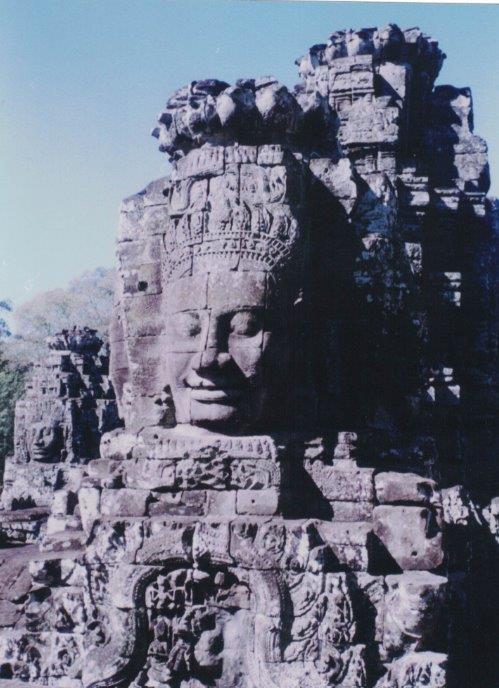
ANGKOR WATT’S DARK NIGHT OF THE SOUL.
Kingdom’s rise and fall, and despite the glory days of Kampuchea’s capital it was not spared from foreign invasion. in 1353 Angkor was invaded by a very superior army from Thailand under King Ramathibodhi who conquered the city and established a Thai presence there for five years. The city was retaken again by a Khmer prince in 1358, but following another invasion in 1370 the capital was moved to Asan. For a short period the capital was moved to Chaktomuk, present day Pnom Penh. But the coup de grace or the final body blown came in 1431 with another massive invasion by a far superior Thai army when the Khmer empire collapsed and the Khmer King fled to Southern Cambodia. Thereafter, at various stages the Kingdom survived in stages. In the 16th century, the Spaniards and Portuguese visited the country and left many reports of their visits to Angkor.
EPILOGUE.
A few years ago I visited Cambodia for a period of three weeks, out of which I spent three days in Siam Reap where the temple complex of Angkor Wat is located. Every morning at dawn I made my way to the entrance of this wonderland and stood awe struck as I watched the golden rays of the morning sun playing on the towers of Angkor and the rippling waters of the huge lake. It was a scene from some heavenly Shangri-La. Having spent a full day immersing myself in the ruins – (there was a lot of walking to be done and it was very tiring, but every step was worth the effort ) – and making copious notes of what seemed an impossible task, I returned to my Hotel at dusk. At night I read Madeleine Giteau’s book which was my travelling companion. This was my “modus operandi” for the entire three days I spent there. Each day I experienced the richness of a bygone age which today has established itself as an icon of Histories mysteries and wonders. The entire Angkor temple complex was created with astonishing precision on a colossal scale which in turn are enduring symbols of historic grandeur – and perhaps the timeless quest for immortality.
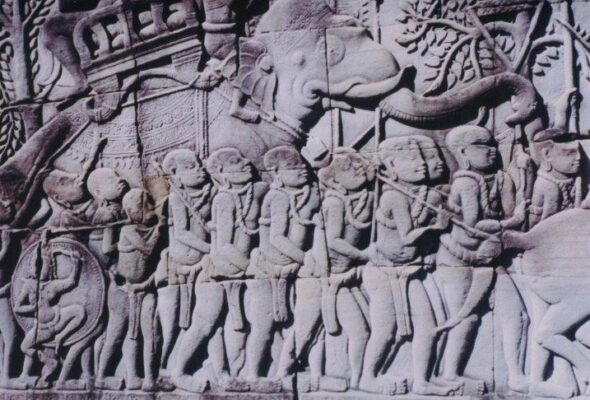
Bernard VanCuylenburg.







